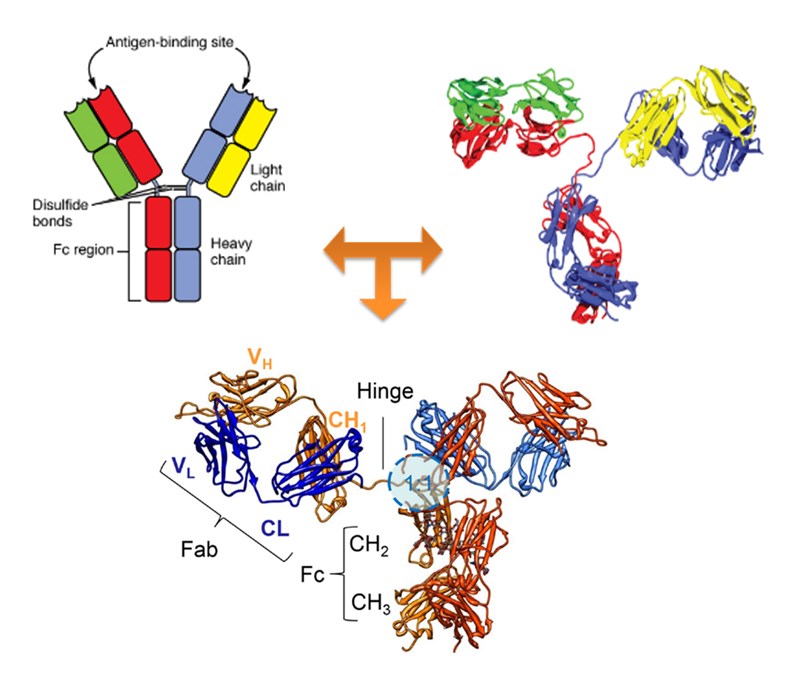Creative Biolabs is a world leading service provider in the field of preclinical drug discovery. Based on abundant experience and experitize scientists, we are capable of offering a full range of antibody characterization and analysis services for global customers. Particularly, we offer antibody tertiary structure analysis service to promote the development of our global customers’ projects.
Tertiary Structure of Antibody
Antibody (immunoglobulin) is a "Y" shaped glycoprotein with four polypeptides-a pair of identical heavy chains and light chains (H₂L₂). According to the different sequences of heavy chains, antibodies are respectively defined as IgA, IgD, IgE, IgG, and IgM, each of which plays a different role in the immune system. The basic H₂L₂ structures consist of the Fc region (fragment, crystallizable) and Fab region (fragment, antigen binding), both of which are mainly composed of β-pleated sheets.
The tertiary structure of antibody refers to a specific three-dimensional structure formed by further fold/coiling of the four polypeptide chains based on the secondary structures or domains. Antibody tertiary structure generally results from the interaction of side-chain groups in secondary structure forming stable secondary bonds. For antibodies, each polypeptide chain has a tertiary structure composed of different domains, in which the basic structural unit of each domain is a barrel-shaped structure formed from two anti-parallel β-sheets. This unique barrel-shaped fold of the antibody is also known as the immunoglobulin fold.
 Fig.1 Antibody structure diagram. (Vidarsson, 2014)
Fig.1 Antibody structure diagram. (Vidarsson, 2014)
Approaches for Tertiary Structure Analysis
The analysis of antibody tertiary structure is of great significance for biological activities and drug discovery. Currently, many approaches and technologies have been developed to characterization and analyze the tertiary structure of antibodies, mainly including but not limited to:
-
X-Ray Crystallography: the most reliable and commonly used method providing high resolution but no conformational flexibility information.
-
Nuclear Magnetic Resonance (NMR): an extensively used method for with lower resolution and providing conformational changes information.
-
Cryogenic Electron Microscopy: an alternative to X-ray crystallography or NMR with the ability of imaging various conformations of biomolecules.
-
Dual Polarisation Interferometry: a preferred method for determining the conformational changes when antibody functions.
 Fig.2 Approaches for antibody tertiary structure analysis.
Fig.2 Approaches for antibody tertiary structure analysis.
Choose Creative Biolabs Antibody for Your Tertiary Structure Analysis
Having been engaged in antibody services for decades, Creative Biolabs now is a senior expert in terms of comprehensive antibody services. We have absolute advantages in providing high-quality antibody structure analysis services based on a series of well-established hardware conditions, such as:
-
Advanced equipment and technical platform
-
Professional scientists with abundant experience and expertise in antibody and protein
-
Combination of two or more methods for better analysis is available
-
Customized services based on your specific demands
In addition to structural analysis, related antibody services also within our ability. For additional details or any questions on our antibody structure analysis services, please for free to contact us.
Reference
-
Vidarsson, G., et al. IgG subclasses and allotypes: from structure to effector functions. Frontiers in immunology. 2014, 5: 520.
For Research Use Only.


 Fig.1 Antibody structure diagram. (Vidarsson, 2014)
Fig.1 Antibody structure diagram. (Vidarsson, 2014)
 Fig.2 Approaches for antibody tertiary structure analysis.
Fig.2 Approaches for antibody tertiary structure analysis.


